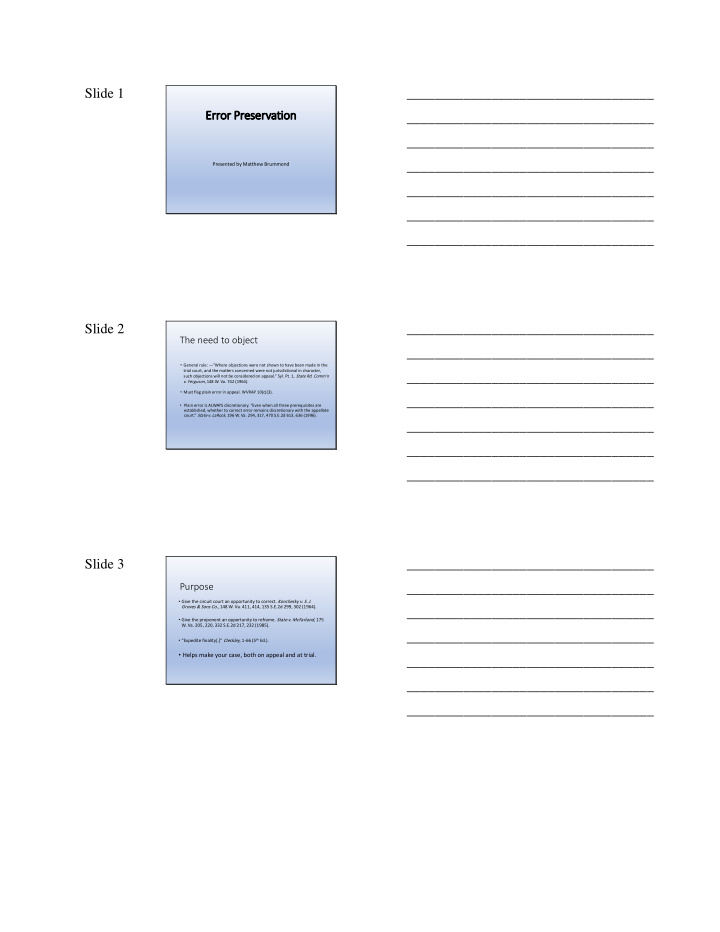



Slide 1 ___________________________________ Error Preserv rvation ___________________________________ ___________________________________ Presented by Matthew Brummond ___________________________________ ___________________________________ ___________________________________ ___________________________________ Slide 2 ___________________________________ The need to object ___________________________________ • General rule: — "Where objections were not shown to have been made in the trial court, and the matters concerned were not jurisdictional in character, ___________________________________ such objections will not be considered on appeal.” Syl. Pt. 1, State Rd. Comm'n v. Ferguson , 148 W. Va. 742 (1964). • Must flag plain error in appeal. WVRAP 10(c)(3). ___________________________________ • Plain error is ALWAYS discretionary. “Even when all three prerequisites are established, whether to correct error remains discretionary with the appellate court.” State v. LaRock , 196 W. Va. 294, 317, 470 S.E.2d 613, 636 (1996). ___________________________________ ___________________________________ ___________________________________ Slide 3 ___________________________________ Purpose ___________________________________ • Give the circuit court an opportunity to correct. Konchesky v. S. J. Groves & Sons Co. , 148 W. Va. 411, 414, 135 S.E.2d 299, 302 (1964). ___________________________________ • Give the proponent an opportunity to reframe. State v. McFarland , 175 W. Va. 205, 220, 332 S.E.2d 217, 232 (1985). ___________________________________ • “Expedite finality[.]” Cleckley , 1-66 (5 th Ed.). • Helps make your case, both on appeal and at trial. ___________________________________ ___________________________________ ___________________________________
Slide 4 ___________________________________ What you need to do: ___________________________________ • Object! • “The rule in West Virginia is that parties must speak clearly in the circuit ___________________________________ court, on pain that, if they forget their lines, they will likely be bound forever to hold their peace…[T]he contours for appeal are shaped at the circuit court level by setting forth with particularity and at the appropriate time the legal ground upon which the parties intend to rely.” SER Cooper v. Caperton , 196 W. Va. 208, 216, 470 S.E.2d 162, 170 (1996). ___________________________________ • W. Va. Crim. P. R. 51, WVRE 103: - Timely - Specific ___________________________________ - Need a ruling ___________________________________ ___________________________________ Slide 5 ___________________________________ Timely ___________________________________ • Contemporaneous enough that court/OC can remedy. ___________________________________ • E.g. State v. Fykes , No. 13-0421, 2016 WL 3356829 (W. Va. 2016). • Criminal depositions —can’t wait until trial. W. Va. Crim. Pro. R. 15(f). ___________________________________ ___________________________________ ___________________________________ ___________________________________ Slide 6 ___________________________________ Specific ___________________________________ • Objection must be particular enough that the opposing party can respond and the court can remedy the mistake. ___________________________________ • Cover all possible grounds. “[S] pecifying a certain ground is…a waiver of other grounds not specified.” Cleckley , 1-56 – 57 (5 th Ed.). ___________________________________ • Does not need to be specific if the problem is obvious.* • General objection will suffice if the court doesn’t give you time to explain yourself. But make your record in some fashion. ___________________________________ ___________________________________ ___________________________________
Slide 7 ___________________________________ General Specific ___________________________________ Appea eals court will affirm if ther ere e is any basis for admitting Likel ely harmles ess if ther ere e is an alter ernative e ev eviden entiary rule e the e ev eviden ence e or if the e proponent nent of the e ev eviden ence e could per ermitting the e admitted ed ev eviden ence. e. have e rem emed edied ed the e problem em had the e objec ection been een spec ecific enough to put them en em on notice. e. Ie Ie , by laying a proper er This is why it’s important to be comprehensive in addition Overruled foundation. to spec ecific. ___________________________________ If ANY ground for exclusion exists, appeals court will affirm. Appeals court will find error if the stated ground for Court will presume the judge ruled upon the proper ground. objection is incorrect. ___________________________________ Loser can overcome this presumption by pressing the judge This is so even if the evidence could have been excluded on to state the ground for sustaining the objection. another ground. Sustained ___________________________________ ___________________________________ ___________________________________ Slide 8 ___________________________________ Need a ruling. ___________________________________ • Court has to rule definitively. ___________________________________ • Move to strike/limit. WVRE 105: “If the court admits evidence that is admissible against a party or for a purpose--but not against another party or for another purpose--the court, on timely request, must restrict the evidence to its proper scope and instruct the jury accordingly.” ___________________________________ ___________________________________ ___________________________________ ___________________________________ Slide 9 ___________________________________ What can go wrong ___________________________________ • Failure to object: Evidence is part of the record and the jury can use it for any purpose. State v. Reed , 223 W. Va. 312, 674 S.E.2d 18 (2009). ___________________________________ • Striking/limiting/vouching are separate requirements. Jones v. Garnes , 183 W. Va. 304, 395 S.E.2d 548 (1990) (per curiam). ___________________________________ • Waiver by use. Keller v. Wonn , 140 W. Va. 860, 87 S.E.2d 353 (1955). But see State v. Richards , 190 W. Va. 299, 438 S.E.2d 331 (1993). ___________________________________ ___________________________________ ___________________________________
Slide 10 ___________________________________ Solution ___________________________________ • Pretrial motions/motions in limine. WVRE 103; W. Va. Crim. P. R. 12(b). ___________________________________ • Motions in limine ARE binding if the ruling is definitive. WVRE 103(b). • Some motions MUST be filed pretrial. W. Va. Crim. P. R. 12(b). ___________________________________ • NOT post-trial motions. See Neill v. Rogers Bros. Produce Co. , 38 W. Va. 228, 18 S.E. 563 (1893). ___________________________________ ___________________________________ ___________________________________ Slide 11 ___________________________________ Specific issues ___________________________________ • Constitutional grounds • Concurrent grounds — e.g. , Confrontation Clause and hearsay ___________________________________ • Co-counsel cases • General objections from opposing counsel ___________________________________ • Opening statement, Closing argument — can object pre-emptively. • Continuing objections recognized in WV. ___________________________________ ___________________________________ ___________________________________ Slide 12 ___________________________________ Strategery ___________________________________ • Consider not objecting to problems of form if it would only result in the opposing counsel an opportunity to be more persuasive. ___________________________________ • Similarly, if a pretrial motion could help OC make a better case. E.g. , bad expert. • Consider whether OC’s inadmissible evidence opens the door.* ___________________________________ *this strategy doesn’t work if the only basis for exclusion is relevance. • Bad reason not to object — worried about the judge’s/jury’s feelings. ___________________________________ ___________________________________ ___________________________________
Recommend
More recommend